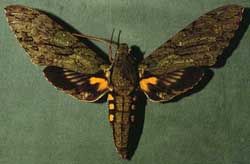Venezuela Sphingini:
Agrius, Amphimoea, Neococytius, Lintneria,
Cocytius, Amphonyx, Morcocytius, Pseudococytius,
Euryglottis
 |
|
|
Updated as per personal communication with María Esperanza Chacín; April 1, 2005 Updated as per Hawkmoths of the World Kitching and Cadiou, 2000; May 2011 Updated as per CATE Sphingidae, 2009; May 17, 2011 |
 |
All images I receive remain the property of respective photographers and are credited as such. Data such as wingspan, date, elevation, precise location, etc., is credited to persons who submit same.
I have arranged the images in accordance with my perception of wing characters: predominent markings, shape, colour, size.
There are probably some Venezuelan species not listed below, and there are some species not officially confirmed for Venezuela, although I think they have a good chance of being found there.
All images that I use are credited to respective photographers and those images remain the property of the photographers. Data submissions are also acknowledged.
I hope that over the next twenty years the site can be further refined to allow for the creation of state by state checklists for Venezuela.
Many thanks to those who have already submitted photos and information. The CATE Sphingidae site has been extremely helpful regarding descriptions and determinations. If there are mistakes on this site, they are my own. Bill Oehlke.

Agrius, Amphimoea, Lintneria, Neococytius
|
Cocytius, Amphonyx, Morcocytius, Pseudococytius |
 Cocytius antaeus Fw upperside semitransparent posterior to vein CuA1; black dash here consequently more or less obliterated; dash posterior to vein M3 heavier, buffish white subbasal line separated into costal, more distal disco-cellular, and posterior part, differing from Cocytius duponchel in that posterior part is more distal, at right-angles to cubital vein and more distal than costal part; the reverse is true in Cocytius duponchel; postdiscal line more curved than in Cocytius duponchel. Both wings undersides often with conspicuous ochre-yellow wash. Hindwing upperside with transparent spaces long, that posterior to vein M1 obviously longer than the brown wing border is broad; these spaces incised distally as the border is dentate between veins; a semitransparent patch that posterior to vein CuA2 anteriorly. |
 Amphonyx duponchel Two thin dark streaks from upper thorax to mid thorax where they expand into teardrops. Forewing upperside with black discal dashes between veins M3 and CuA2 not prominent; discal spot transverse, kidney-shaped, dirty white. Hindwing upperside with translucent patch posterior to vein M1 shorter than the black marginal band is broad at vein M1  Amphonyx lucifer Thorax: black markings prominent against greyish green. Abdomen: mesial line usually prominent, sometimes faint or widely interrupted. Ground colour varies from walnut shell, yellowish-brown to greenish-grey. Two narrow, distinct dark streaks posterior to veins M3 and CuA1. |
 Pseudococytius beelzebuth More orangey-brown shading on forewing than in other species in this group. Strong presence of black diagonal line from costa to cell. Line, interrupted by cell, continues as thicker, shorter black bar, parallel to inner margin. Black, much thinner streak often interrupted above bar. |
Euryglottis
|
Visit Sphingini: Manduca
You are here: Sphingini: Agrius, Amphimoea, Cocytius, Euryglottis, Lintneria, Sphinx
Visit Smerinthini: Adhemarius and Protambulyx
Visit Dilophonotini: Aleuron, Baniwa, Enyo, Kloneus, Pachygonidia and Unzela
Visit Dilophonotini: Aellopos, Eupyrrhoglossum, Nyceryx, Perigonia and Stolidoptera
Visit Dilophonotini: Callionima, Erinnyis, Hemeroplanes, Isognathus, Madoryx, Oryba, Pachylia, Pachylioides, Phryxus
and Pseudosphinx
Visit Philampelini: Eumorpha
Visit Macroglossini: Hyles and Xylophanes
Use your browser "Back" button to return to the previous page.
This page is brought to you by Bill Oehlke and the WLSS. Pages are on space rented from Bizland. If you would like to become a "Patron of the Sphingidae Site", contact Bill.
Please send sightings/images to Bill. I will do my best to respond to requests for identification help.
 Show appreciation for this site by clicking on flashing butterfly to the left. The link will take you to a page with links to many insect sites. |